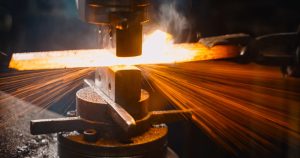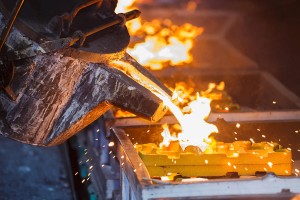Steel is one of the most important materials in human history, forming the backbone of modern infrastructure, transportation, and countless industries. Its strength, versatility, and durability have made it essential for construction, manufacturing, and even the development of entire economies. The history of steel manufacturing is a long and fascinating journey, spanning millennia of technological advancements and cultural milestones. This article explores the evolution of steel manufacturing, from its ancient origins to the modern innovations that define the industry today.
Early Beginnings: Iron and the Dawn of Steel
The story of steel begins with the discovery and use of iron, which predates the invention of steel by thousands of years. Around 1200 BCE, during the Iron Age, humans began to extract iron from ore and craft tools, weapons, and other items. This process, however, resulted in wrought iron—soft and ductile material that lacked the strength and hardness of steel. Ancient blacksmiths knew how to produce small amounts of steel by reheating wrought iron and incorporating carbon, but it was largely a trial-and-error process.
The earliest known production of steel can be traced to ancient civilizations in India around 300 BCE, where high-carbon steel known as “Wootz steel” was produced using crucible techniques. Wootz steel became famous for its superior quality, known for its sharpness and durability, and it spread throughout the Middle East, Africa, and Europe through trade routes.
In Europe, particularly during the Roman era, the art of producing steel was less advanced. The material was primarily used for making weapons and armor, but the methods were inconsistent and inefficient.
The Middle Ages and the Introduction of the Blast Furnace
During the Middle Ages, significant advancements were made in the production of iron and steel. One of the most important developments was the invention of the blast furnace, which emerged in China around the 11th century and spread to Europe by the 14th century. The blast furnace allowed for higher temperatures, which could melt iron and remove impurities more efficiently than previous methods.
However, the blast furnace initially produced “pig iron,” which was brittle and contained too much carbon. To make usable steel, blacksmiths would refine this pig iron by reducing the carbon content through a process known as “fining” or “puddling.” Despite these improvements, steel production remained slow, labor-intensive, and inconsistent in quality.
The Industrial Revolution: The Birth of Modern Steelmaking
The turning point in steel manufacturing came during the Industrial Revolution in the 18th and 19th centuries. This period saw rapid advancements in technology, energy production, and industrial processes, which transformed steel from a luxury material to a mass-produced commodity.
One of the most important innovations of the era was the Bessemer Process, invented by English engineer Henry Bessemer in 1856. This process involved blowing air through molten pig iron to burn off excess carbon and impurities, transforming the material into steel in a faster, cheaper, and more efficient way than ever before. The Bessemer Process revolutionized steelmaking, making it possible to produce large quantities of steel for use in railroads, bridges, and buildings during the expansion of industrial cities.
Shortly after, the Siemens-Martin Process, developed by German engineer Carl Wilhelm Siemens and French engineer Pierre-Émile Martin in the 1860s, provided an alternative method of steelmaking. The Siemens-Martin open-hearth furnace used regenerative heating to produce higher-quality steel than the Bessemer process, allowing for greater control over the chemical composition of the steel. The open-hearth process became the dominant method of steel production until the mid-20th century.
During this period, steel began to replace iron in many applications, thanks to its superior strength and flexibility. The construction of steel-frame buildings, such as skyscrapers and bridges like the Brooklyn Bridge (1883), marked the rise of steel as a fundamental material in modern architecture and engineering.
The 20th Century: Refining Steelmaking Processes
The 20th century saw further advancements in steel manufacturing as new technologies and methods were developed to meet the growing demand for steel in industries such as automotive, shipbuilding, and construction.
One of the most significant innovations was the development of the Basic Oxygen Furnace (BOF) in the 1950s, which replaced the Bessemer and open-hearth processes as the primary method of steel production. The BOF process involves blowing oxygen into molten pig iron to reduce the carbon content and produce steel. This method is faster and more efficient than previous techniques, allowing for mass production of steel with high quality and consistency.
Another important development in the 20th century was the rise of the Electric Arc Furnace (EAF), which uses electricity to melt scrap steel or direct reduced iron (DRI). Unlike the BOF, which requires large blast furnaces and raw materials like iron ore, the EAF process can use recycled steel, making it more environmentally friendly and energy-efficient. The EAF became a key component of “mini-mills,” smaller steel production facilities that focus on recycling scrap metal.
The Modern Era: Sustainability and Innovation
In the 21st century, steel manufacturing continues to evolve, driven by the need for greater efficiency, sustainability, and environmental responsibility. The steel industry, which accounts for roughly 7-9% of global CO2 emissions, faces increasing pressure to reduce its carbon footprint and adopt greener technologies.
One of the most promising developments in recent years is the adoption of hydrogen-based steelmaking, which uses hydrogen instead of carbon-based fuels to reduce iron ore into steel. This method, known as green steel, has the potential to significantly reduce greenhouse gas emissions associated with steel production. Several companies and countries are investing in hydrogen steelmaking as part of broader efforts to decarbonize the industry.
Additionally, advancements in recycling technology and the increased use of Electric Arc Furnaces are helping to reduce the environmental impact of steel production. By recycling scrap steel and reducing the need for raw materials, the steel industry can lower energy consumption and reduce waste.
The development of high-strength, lightweight steel alloys is another area of innovation. These new materials are used in industries like automotive manufacturing, where reducing the weight of vehicles helps improve fuel efficiency and reduce emissions. Modern steel alloys offer a balance between strength, durability, and weight, making them essential for applications in aerospace, construction, and energy sectors.
Conclusion
The history of steel manufacturing is a testament to human ingenuity and the drive for progress. From ancient blacksmiths experimenting with iron and carbon to modern innovations in sustainable steel production, the evolution of steel has shaped the development of societies, economies, and industries around the world. As the industry continues to face new challenges, including the urgent need to reduce its environmental impact, the future of steel manufacturing will likely be defined by further innovations in technology, materials, and sustainability practices.
As one of the most essential materials in modern life, steel remains at the heart of progress, helping to build the infrastructure, vehicles, and technologies that define our world today. RDR Steel Sales supplies industries across North America with new & used steel shipping bins, used shipping baskets and collapsible plastic bins.



